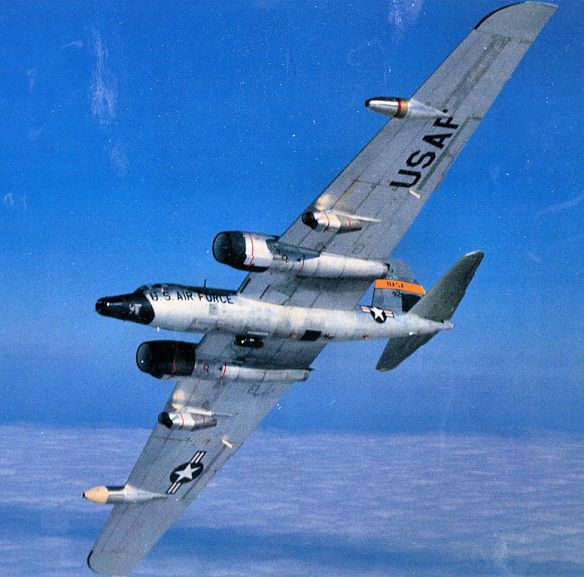Military Air Transport Service (and its successor organization Military Airlift Command) was frequently used by the USAF for clandestine, special operations missions prior to the establishment of Air Force Special Operations Command in the 1980s. The RB-57F, with its very high-altitude ceiling was frequently used as a strategic reconnaissance aircraft when necessary. Four of the aircraft were operated as reconnaissance aircraft, two with the 56th SRS at Yokota, and two with the 59th SRS at Kirtland AFB. The aircraft at Kirtland AFB were deployed to Europe where they were operated by the 7407th Support Squadron at Rhein-Main AB, West Germany.
On 14 December 1965, one of the RB-57Fs (63-13287) operating from Rhein-Main AB was lost during a mission over the Black Sea. What actually happened is still uncertain. There were reports that the aircraft had been shot down by a Soviet S-75 Dvina Surface-to-air missile, but at the time, the official statement by the USAF was that the aircraft crew had probably perished from an oxygen system failure, since it took over an hour for the aircraft to spiral down from altitude and fall into the Black Sea. Although seven or eight days were spent searching for the wreckage, only small bits and pieces of it were ever found. However, there were also reports that the two crew members were captured alive by the Soviets, with their ultimate fate being uncertain.
In 1965, one RB-57F from the 56th SRS on loan to Pakistan, during the Indo-Pakistani War of 1965, was operated by 24 Squadron of the Pakistan Air Force. The original reason for the 56th SRS deployment to Pakistan was to monitor Communist Chinese nuclear tests, which had begun in October 1964. The aircraft were flown by USAF crews during these operations. One of the RB-57Fs was returned to Yokota AB before the outbreak of hostilities with India, but the other remained.
With American agreement, the RB-57F operated by No 24 Squadron used the aircraft to carry out daily sorties over Indian Air Force airfields at altitudes of up to 65,000 ft, carrying out strategic reconnaissance. The RB-57F was also locally modified by the PAF to carry a 4,000 lb bombload, but it was never actually operated in a bombing role. On some occasions, the RB-57F operated alongside a pair of PAF B-57Bs that were jamming Indian military radio transmission and were monitoring the location of the Indian Army’s mobile radar installations.
All three aircraft were involved in directing attacks on the Indian radar station at Amritsar, and during these operations, one of the PAF B-57Bs was shot down in error by Pakistani Anti-Aircraft Artillery. Eventually, on 15 September 1965, the aircraft was straddled by two SA-2 SAMs as it commenced its descent towards Peshawar. Despite suffering major structural damage and sustaining over 170 holes, the pilot managed to nurse the aircraft back to Peshawar where he made a successful forced landing. The aircraft was eventually repaired and returned to the USAF.
In August 1955, the 7406th and 7407th Support Squadrons based at Rhein-Main were equipped with two variants of the RB- 57A, the HEART THROB photoreconnaissance aircraft, and the SHARP CUT combined electronic and photographic-capable version. On 11 December 1956, three RB-57Ds flew from Yakota, Japan, on separate missions over Vladivostock. MiG-17s were scrambled to intercept them, but none could climb to 64,000 feet. A formal Soviet protest was delivered on 15 December, and President Dwight D. Eisenhower terminated the program.
In June 1959, they were replaced by the RB-57D with longer wings, but the unit was eventually disbanded, having been made redundant by the U-2 and following the loss of an RB-57F from Incirlik with a crew of two over the Black Sea in December 1965. The pilot seems to have lost control of his aircraft at its cruising altitude of 80,000 feet and plunged into the sea. Part of a wing was recovered by a Turkish destroyer in international waters and other wreckage was winched aboard Soviet trawlers.
TECHNICAL NOTES:
Number built/converted RB-57F 21 (cv)
Armament: None (although the bomb bay could be converted to carry bombs if necessary)
Engines: Two Pratt & Whitney TF33-P-11 turbofans of 16,000 lbs. static thrust each, plus two (removable) Pratt & Whitney J60-P-9 turbojets of 3,300 lbs. static thrust each
Maximum speed: 550 mph / 475 knots
Range: 4,000 miles / 3475 nautical miles
Service ceiling: 82,000 ft.
Span: 122 ft. 5 in.
Length: 68 ft. 10 in.
Height: 19 ft. 0 in.
Crew: Two (pilot and navigator-observer)
Serial numbers: 63-13286 to 63-13302; 63-13500 to 63-13503
